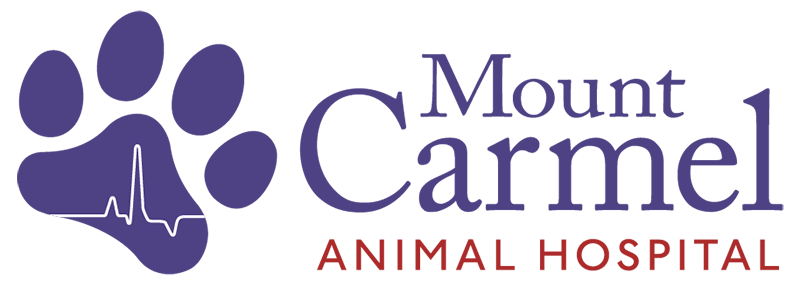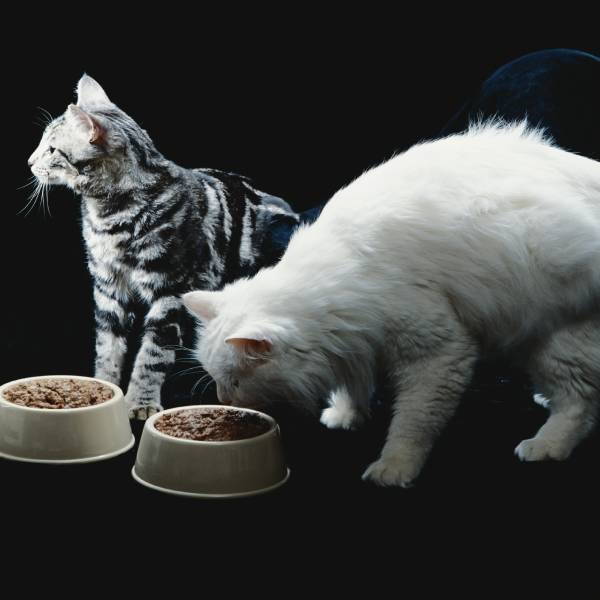Helping your pet maintain a healthy weight is one of the most important things you can do to support their long-term health and happiness. At Mount Carmel Animal Hospital, we offer expert insight, individualized guidance, and ongoing support to help you make that happen—at every stage of your pet’s life.
Just like in people, excess weight in pets can lead to serious health problems—like diabetes, arthritis, liver disease, and even some cancers. It also increases everyday discomfort and can shorten your pet’s lifespan by years.
Obesity is one of the most common health concerns in pets, and it’s not always just about diet. While overfeeding and lack of exercise are major contributors, other factors—like age, breed, genetics, and underlying medical conditions (such as hypothyroidism or Cushing’s disease)—can also play a role. Our approach goes beyond calorie counting. We take the time to understand your pet’s specific needs and create a plan that’s safe, realistic, and effective.
Did you know?
-
- Overweight dogs live 2–2.5 years less on average than dogs at a healthy weight
- 56% of dogs and 61% of cats in the U.S. are overweight or obese
- Obesity increases whole-body inflammation—raising the risk of arthritis, diabetes, and cancer
Obesity develops when energy intake exceeds energy use—leading to fat storage that can persist even after overeating stops. Certain breeds (like Labrador Retrievers and Pugs) and older pets are especially prone. That’s why early detection and long-term support are key.
At MCAH, we’re here to help you navigate every step. Our veterinarians provide nutritional counseling, including specific diet recommendations and portion planning. Our rehab team offers canine fitness programs that include underwater treadmill therapy, strength-building exercises, and custom at-home routines. Whether your pet is facing early weight gain or struggling with long-term obesity, we’re here with real answers and practical solutions.
How can I tell if my pet is overweight?
The best way to tell if your pet is overweight is to evaluate their Body Condition Score (BCS)—a simple system used by veterinarians to assess whether your pet is underweight, overweight, or in ideal condition.
At home, you can use a few visual and physical cues:
-
- Ribs: You should be able to feel your pet’s ribs easily without pressing hard, but they shouldn’t be visibly protruding.
- Waist: Look from above—your pet should have a visible waistline behind the ribs.
- Tuck: From the side, their belly should tuck up instead of hanging down.
Use the Purina Body Condition Score (BCS)
Not sure where to start? Watch these quick guides:
How to Tell If Your Dog Is Overweight – Purina BCS Video
Purina Body Condition System – DOG
How to Tell If Your Cat Is Overweight – Purina BCS Video
Purina Body Condition System – CAT
These short videos walk you through the Body Condition Score system, so you can evaluate your pet’s weight at home with confidence.
Signs your pet might be overweight include:
-
- Loss of visible waistline or belly tuck
- Difficulty feeling ribs
- Less interest in activity or tiring more easily
- Trouble jumping, climbing stairs, or moving around
- New or worsening joint stiffness or limping
- Changes in breathing, especially after mild exertion
If you’re unsure or concerned, our team is always happy to evaluate your pet’s weight and body condition. We’ll talk through what we see, what it means, and what next steps—if any—might help.
Why is my pet gaining weight if they don’t eat that much?
It’s a question we hear often—and one that deserves a thoughtful answer. At Mount Carmel Animal Hospital, we know that weight gain isn’t always about too much food. Sometimes the reasons are less obvious, and figuring it out takes experience, insight, and a closer look at your pet’s health and habits.
Here are a few of the most common factors:
-
- Reduced activity levels – Even if your pet’s food hasn’t changed, lower daily movement—due to aging, boredom, pain, or weather—can lead to gradual weight gain.
- Age and metabolism – As pets get older, their calorie needs often decrease. If feeding routines don’t adjust accordingly, slow weight gain can sneak up over time.
- Untracked extras – Treats, table scraps, shared food between pets, or even dental chews can add more calories than expected—even when meals seem modest.
- Medical conditions – Issues like hypothyroidism, Cushing’s disease, or fluid retention can lead to unexpected weight gain or changes in body shape. These conditions may also make it harder for pets to lose weight without medical support.
- Breed tendencies – Some breeds are genetically more prone to weight gain (like Labradors, Beagles, and Pugs) and may require more careful management, even with limited food.
- Spay/neuter changes – After spaying or neutering, hormonal shifts can affect appetite or metabolism. This doesn’t cause obesity on its own, but it can influence how your pet responds to their current diet.
One common pitfall is not measuring food precisely. It’s easy to overfeed when meals are “eyeballed” or scooped with a mug, coffee cup, or unmarked container. Even small overestimates—just a handful of extra kibble per day—can lead to noticeable weight gain over time. That’s why we recommend using a standard measuring cup to portion your pet’s food accurately and consistently. Pick up a free food measuring cup at our front desk.
If your pet is gaining weight and you’re not sure why, you’re not alone—and we can help. Our team will take time to understand what’s happening, explore possible causes, and offer clear, realistic next steps. Whether it’s a simple adjustment or a deeper medical concern, we’re here with expert insight, personalized guidance, and support that makes a difference.
What’s the best diet for weight loss?
The best diet for weight loss is one that’s nutritionally balanced, portion-controlled, and tailored to your pet’s specific needs. At Mount Carmel Animal Hospital, we don’t believe in one-size-fits-all solutions—we help you choose a diet that works for your pet’s age, breed, lifestyle, and health status.
We may recommend:
-
- A prescription weight-loss formula designed to help pets feel full with fewer calories such as Purina Pro OM Overweight Management
- A high-protein, high-fiber diet that maintains muscle while supporting safe fat loss
- A low-calorie version of your current food (in some cases) with precise portioning
- A specialized diet if your pet has other health concerns (like diabetes, kidney disease, or food sensitivities)
Choosing the right food is only part of the equation. Accurate portion control, a consistent feeding schedule, and limiting treats and extras are just as important. We’ll calculate your pet’s daily calorie needs and create a feeding plan that’s realistic and effective—without making your pet feel deprived.
If your pet needs to lose weight, we’ll guide you through every step—with product recommendations, transition tips, and regular check-ins to help you track progress and make safe adjustments along the way.
My pet always seems hungry and is begging for food. What should I do?
It’s a challenge many pet owners face—and one that can be frustrating, confusing, or even guilt-inducing. At Mount Carmel Animal Hospital, we understand how hard it is to say no when your pet looks at you with pleading eyes. But constant hunger or begging isn’t always a sign that your pet needs more food. Sometimes it’s about habits, attention-seeking, or an underlying medical issue.
Here are a few possible reasons your pet might always seem hungry:
-
- Inadequate calories or nutrient balance – Some low-quality or reduced-calorie diets may leave pets feeling unsatisfied. We can help assess whether your pet’s current food is meeting their needs.
- Feeding routines and reinforcement – If your pet gets fed (or receives treats) in response to begging, it can unintentionally reinforce the behavior.
- Boredom or anxiety – Some pets beg out of habit, not hunger—especially if they lack stimulation, exercise, or engagement throughout the day.
- Medical causes – Conditions like diabetes, Cushing’s disease, or certain parasites can lead to true, excessive hunger (polyphagia).
What you can do:
-
- Make sure your pet’s diet is appropriate for their weight loss or maintenance needs—and that meals are properly measured and balanced.
- Try feeding smaller meals more frequently to help keep them satisfied throughout the day.
- Offer low-calorie options for enrichment, like frozen green beans, carrots, or interactive feeders that slow down eating and add mental stimulation.
- Avoid using food as the primary source of interaction. Try redirecting with toys, play, or a walk.
- Avoid “accidental feeding” from multiple household members by keeping a feeding log.
If your pet’s hunger seems excessive or is paired with weight gain, weight loss, or other symptoms, it’s time to talk with us. We’ll help determine whether the issue is behavioral or medical—and provide the guidance and support to manage it in a way that works for both you and your pet.
Can obesity really shorten my pet’s life?
Yes—obesity can significantly impact your pet’s health and shorten their lifespan. Whether you have a dog or a cat, carrying extra weight increases the risk of serious health problems and can reduce both the length and quality of life.
Studies show that overweight dogs may live 2 to 2.5 years less than dogs at a healthy weight. While similar long-term studies in cats are limited, veterinarians consistently see that obese cats are at much higher risk for diabetes, joint problems, heart disease, and decreased mobility—all of which affect longevity.
In both dogs and cats, obesity increases the risk of:
-
- Arthritis and joint pain
- Type 2 diabetes (especially in cats)
- Liver disease (including hepatic lipidosis in cats)
- Heart and respiratory issues
- High blood pressure
- Lower energy and exercise intolerance
- Increased risk under anesthesia or during surgery
- Some types of cancer
Even a small amount of weight loss can make a big difference. It can improve comfort, reduce pain, boost energy, and support better long-term health. That’s why at Mount Carmel Animal Hospital, we take a thoughtful, collaborative approach to weight management—focused on real solutions and compassionate support.
If you’re concerned about your pet’s weight, we’re here to help. Together, we can create a personalized plan that works for you and helps your pet live a longer, healthier life.
How can I safely exercise my overweight pet?
When a pet is overweight or obese, jumping into an intense exercise routine can do more harm than good. At Mount Carmel Animal Hospital, we take a safe, step-by-step approach to increasing activity—focused on comfort, mobility, and long-term success.
Here’s what we recommend:
Start slow and build gradually
-
- Begin with short, low-impact activities—like leash walks, gentle play, or climbing a few stairs.
- Gradually increase time and intensity based on your pet’s comfort and stamina.
- Monitor for signs of fatigue, limping, or labored breathing—and stop if they appear.
Choose low-impact options
-
- For dogs, short walks or underwater treadmill sessions are excellent ways to reduce joint stress.
- For cats, interactive play (with wands, lasers, or treat-dispensing toys) can encourage movement in short bursts.
- Avoid high-impact activities like jumping, running, or long hikes until your pet is closer to a healthy weight.
Incorporate movement into daily life
-
- Use food puzzles or treat balls to encourage movement during feeding.
- Scatter small portions of food to make mealtime more active.
- Set short play sessions throughout the day instead of one long one.
Ask us about a custom fitness plan
Our rehabilitation team offers personalized exercise programs—including strength training, conditioning, and therapeutic exercises tailored to your pet’s size, weight, and health status. Whether you need an at-home plan or in-clinic fitness sessions, we’ll help you get started safely.
Exercise is a key part of weight loss—but it should never cause pain or stress. If you’re not sure what’s safe, we’ll guide you through it. Together, we’ll help your pet move more, feel better, and thrive.

